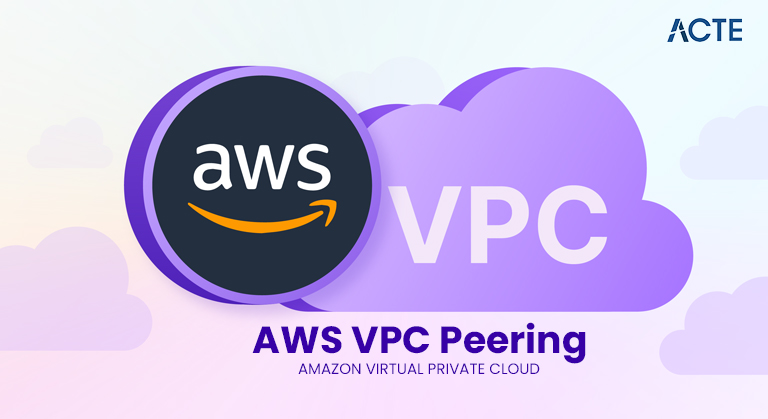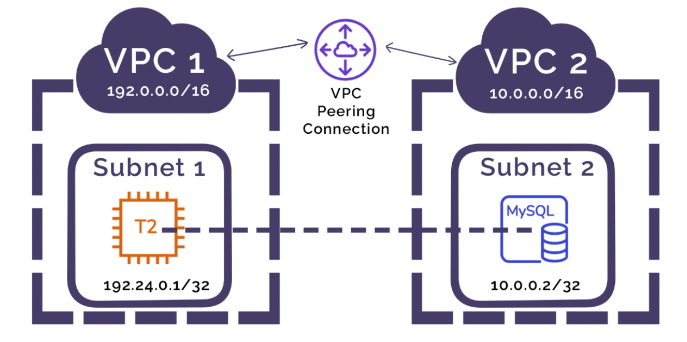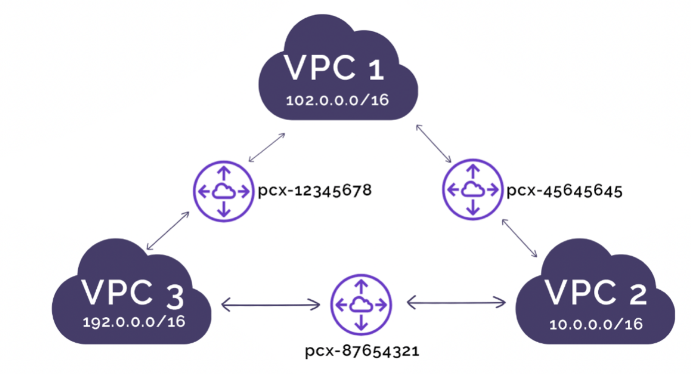
- Introduction to AWS VPC Peering
- Key Features of AWS VPC Peering
- How AWS VPC Peering Works
- Setting Up VPC Peering in AWS
- Security and Compliance Considerations
- Performance Optimization Best Practices
- Use Cases of AWS VPC Peering
- Troubleshooting Common VPC Peering Issues
- Real-World Implementation Scenarios
- Conclusion
Introduction to AWS VPC Peering
AWS VPC Peering is a networking connection that enables private communication between two Amazon Virtual Private Cloud (VPCs) within the AWS ecosystem. It allows resources in different VPCs to communicate securely as if they were in the same network. This feature eliminates the need for internet gateways, VPNs, or NAT devices, ensuring low-latency and high-bandwidth connectivity between environments. VPC Peering supports cross-account and cross-region connections, making it a valuable solution for businesses integrating workloads across multiple AWS environments, as highlighted in Amazon Web Services Training. Amazon Virtual Private Cloud Peering is particularly useful when businesses operate multiple production, development, and testing environments. Organizations that require cross-departmental communication between different AWS accounts or regions also benefit from VPC Peering. By leveraging direct private IP connections, businesses can enhance security, improve network performance, and reduce costs associated with data transfer over the public internet.
Interested in Obtaining Your Cloud Computing Certificate? View The AWS Certification Training Offered By ACTE Right Now!
Key Features of AWS VPC Peering
- Secure Communication: Direct private IP communication between VPCs without public internet use.
- High Bandwidth & Low Latency: Provides fast, reliable, and cost-effective data transfer between connected VPCs, as explained in the Guide to Azure Site Recovery.
- Cross-Region Support: Enables VPC peering between different AWS regions for global infrastructure connectivity.
- Cross-Account Peering: Allows multiple AWS accounts to establish peering connections.
- No Single Point of Failure: Peering connections operate without relying on a third-party service.
- Scalability: Supports multiple VPC peering connections within the same AWS account or across different accounts.
- Cost-Effective: Data transfer costs are lower than those of VPN or Direct Connect alternatives.
- No Bandwidth Constraints: Unlike AWS Transit Gateway, VPC Peering has no fixed bandwidth limit.
- Create a Peering Request: In the AWS Management Console, navigate to the VPC dashboard and create a VPC Peering connection.
- Select VPCs: Choose the requester and acceptor VPCs for the peering connection.
- Accept the Peering Request: The owner of the acceptor VPC must confirm and approve the connection.
- Modify Route Tables: Update the route tables of both VPCs to allow traffic flow between them.
- Adjust Security Groups: Modify security group rules to permit inbound and outbound communication.
- Test Connectivity: Verify that instances in the peered VPCs can communicate via private IP addresses, as part of the process in building Scalable and Secure Microservices on AWS.
- Monitor Network Performance: Use AWS CloudWatch and VPC Flow Logs to analyze network traffic.
- Monitoring & Logging: Use AWS CloudTrail and VPC Flow Logs to track network activity.
- IAM Policies: Restrict VPC Peering access to authorized users within an AWS account.
- Network ACLs and Security Groups: Ensure proper firewall rules for traffic control.
- No Transitive Routing: Each peering connection must be explicitly configured to prevent unintended access.
- Encryption & Data Protection: Since peering occurs over AWS’s private network, additional encryption may be necessary for regulatory compliance.
- Least Privilege Access: Implement the principle of least privilege to restrict unnecessary communication between VPCs.
- Multi-VPC Architectures: Connect multiple VPCs for seamless workload integration.
- Cross-Account Collaboration: Allow secure private communication between VPCs in different AWS accounts.
- Hybrid Cloud Deployments: Extend on-premises infrastructure to AWS through peering with cloud VPCs.
- Disaster Recovery: Replicate data between VPCs in different regions for redundancy, while ensuring secure access through AWS Security Token Service.
- Shared Services Infrastructure: Centralize standard services such as authentication, logging, and monitoring across multiple VPCs.
- Peering Request Not Accepted: Ensure the receiving VPC owner accepts the request.
- Route Table Misconfiguration: Verify that correct routes are added to both VPCs.
- Security Group Restrictions: Check that firewall rules allow traffic between VPCs.
- DNS Resolution Not Working: Enable private DNS resolution for seamless hostname lookups.
- Cross-Region Latency Issues: Use monitoring tools to analyze network performance across regions.

How AWS VPC Peering Works
AWS VPC Peering establishes a direct connection between two VPCs, allowing private communication between their resources. To set up a peering connection, one VPC owner sends a peering request to another VPC, and the recipient must accept it. Once received, route tables must be updated to allow traffic to flow between the VPCs. Unlike AWS Transit Gateway, VPC Peering does not support transitive routing, meaning data cannot pass through one VPC to reach another VPC indirectly, a concept discussed in Azure Availability Sets vs Zones. Instead, direct peer-to-peer connections must be established for each VPC to communicate. VPC Peering is a one-to-one connection between two VPCs, meaning that every new VPC connection requires a separate peering link. This limitation makes it less ideal for large-scale, multi-VPC architectures. Organizations that need centralized management of multiple VPCs should evaluate AWS Transit Gateway as an alternative solution.
Want To Explore AWS in Depth, Check Out Our Comprehensive AWS Certification Training To Gain Insights From Our Experts!
Setting Up VPC Peering in AWS

Security and Compliance Considerations
Performance Optimization Best Practices
Optimizing AWS VPC Peering connections is essential for ensuring efficient and cost-effective communication between VPCs. To minimize costs, it is important to reduce unnecessary data transfers between peered VPCs by designing the network architecture with proper segmentation and route management. Leveraging private DNS resolution for peer connections simplifies service discovery, allowing VPCs to easily access resources in other VPCs using internal DNS names, without needing to configure public IPs or third-party solutions. Careful management of route table entries is also crucial to avoid accidental misconfigurations that could lead to connectivity issues or security risks, a key aspect taught in AWS Training. By regularly reviewing and optimizing route tables, businesses can ensure that traffic flows as intended between VPCs. To monitor network performance and identify bottlenecks, organizations should use AWS CloudWatch and AWS VPC Flow Logs. These tools provide valuable insights into traffic patterns, helping to pinpoint areas of improvement and optimize performance. Additionally, designing the network with well-defined CIDR blocks ensures there are no IP address conflicts between peered VPCs, maintaining network integrity and avoiding communication issues. By following these best practices, businesses can maximize the efficiency, security, and scalability of their VPC Peering connections.
Gain Your Master’s Certification in AWS by Enrolling in Our AWS Masters Course.
Use Cases of AWS VPC Peering
Troubleshooting Common VPC Peering Issues
Real-World Implementation Scenarios
Organizations across various industries use AWS VPC Peering to build secure and efficient network architectures tailored to their specific needs. For example, a financial services company might use VPC Peering to connect separate VPCs for trading platforms and customer account management systems, ensuring secure communication between these critical systems while maintaining isolation for security. A healthcare provider could leverage VPC Peering to keep sensitive patient data within one VPC, while allowing secure access to applications hosted in another VPC, ensuring compliance with industry regulations like HIPAA, as explained in Understanding ARNs in AWS. In the case of a global e-commerce company, cross-region VPC Peering enables synchronization of inventory data between regional warehouses and data centers, ensuring real-time updates and efficient operations across multiple geographic locations. By using VPC Peering, organizations can securely and cost-effectively link different VPCs, supporting complex use cases and driving operational efficiency.
Preparing for a AWS Job Interview? Check Out Our Blog on AWS Interview Questions & Answer
Conclusion
AWS VPC Peering provides a secure and low-latency connection between Virtual Private Clouds (VPCs), enabling seamless communication between resources in different VPCs. This is particularly beneficial for businesses that require multi-VPC architectures, hybrid cloud setups, or secure cross-account networking. With VPC Peering, organizations can establish private communication channels between VPCs, facilitating efficient data transfer and resource sharing across different networks. VPC Peering is a cost-effective solution for direct VPC-to-VPC connections, allowing businesses to connect multiple VPCs without requiring an intermediary, a concept often covered in AWS Training. It is particularly suitable for simpler networking scenarios where only a few VPCs need to communicate. However, for more complex network architectures, such as those requiring centralized management or connections to large numbers of VPCs, AWS Transit Gateway might be a more appropriate solution. Transit Gateway enables scalable and centralized network management, improving the efficiency of complex cloud architectures. To maximize the benefits of AWS VPC Peering, businesses should follow best practices for network design and optimize routing configurations. By properly managing route tables, limiting unnecessary peering connections, and considering traffic flow patterns, organizations can maintain security and cost efficiency. With careful planning and strategic implementation, AWS VPC Peering can significantly enhance an organization’s networking capabilities while ensuring robust security and performance.





